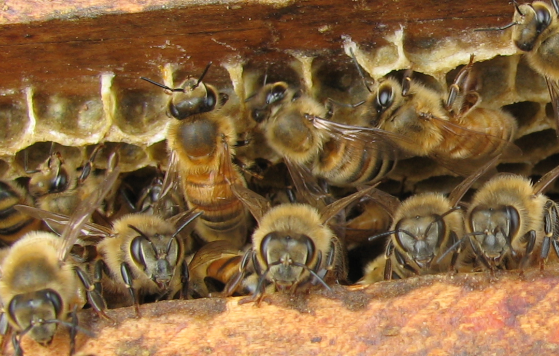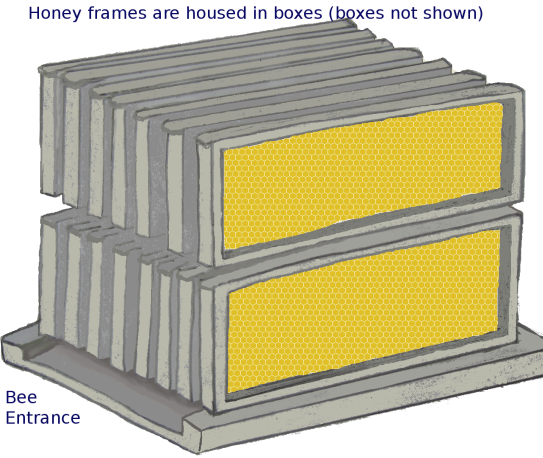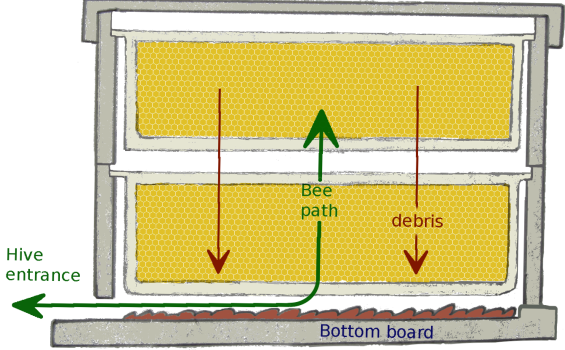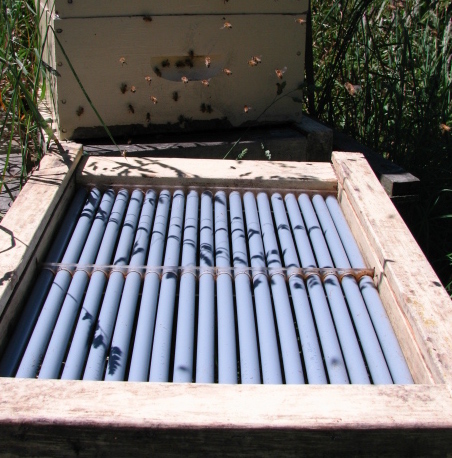The housing of domestic bees
Bees are industrious, organised and intelligent. Instead of explaining this in an article, I submit the following photo to the reader. See how those bees are watching me whilst I was checking out their health by opening their hive.

Like other Fauna and Flora, bees have been domesticated. The environment of domestic bees were changed by the introduction of artificial hives. Most honey bees are managed in in boxes where they store their honey in rectangular combs that are easily harvested. Feral colonies (bee colonies their native habitat) are not the norm. Whilst a lot of feral bees have been decimated by pests like the Varroa mite, feral colonies have proven to be more resistant to pests than domesticated bees.
Man-made beehives normally adopt the Langstroth design. Bees store their honey and babies in frames. About nine of these frames are placed in boxes. A number of these boxes are stacked on a “bottom board”.

Bees normally land on the bottom board and walk into the hive entrance at the bottom.
At the end of spring, bee keepers empty about half the honey out of each hive. Some commercial bee-keepers can be mercenary about the amount of honey they harvest. To ensure that bees make it through winter, bee-keepers feed the bees sugar water or an equivalent. This is like raiding the fruit and veggies and replacing it McDonalds food.
Varroa mites are like big ticks. If you were the size of a bee, a Varroa mite l;arger than a rat would be sucking your blood. A bee with more than one Varroa mite does not last long. Most bee-keepers use insecticides to control the amount of Varroa.
Bees will clean out their hives by removing dead bees, waste, the odd Varroa mite and other debris from the combs. As bottom boards are flat, the debris normally accumulate there. The beehive entry point therefore become the accumulation point of the hive debris.

Live mites often end up on the bottom board with the debris, where they can re-attach themselves to bees that walk in and out of the hive.
Some bee colonies spend more effort on hive hygiene by cleaning out their hives. It is well known that bees that are hygienic are more resistant to Varroa mite and pests.
Many scientist say there is no single cause to “colony collapse disorder”. “Colony collapse disorder” seems to be related to infections and Varroa.
The hive can be seen as an ecosystem that include bees and bee pests. The introduction of the artificial hive has changed this ecosystem, allowing pests to evolve their behavior to gain a competitive advantage.
Unhygienic hives are a breeding ground for many illnesses and may be the cause of colony collapse disorder (just like damp, drafty houses cause many illnesses in humans)
One method to improve the hygiene design of bee boxes, is to install a bottom board that allow debris (including live Varroa mites) to fall through onto the ground.
I have made such a bottom board,- as shown in the picture.

2 thoughts on “The housing of domestic bees”
An interesting idea. I would tend to think is to be way to airy for cold climates. We had a hive of wild bees live in the wall of our house for years, until they were removed. They were getting through a small gap in rough lumber siding, about half way up the second story wall. So they don’t need alot of airiness to be happy. Perhaps a fine screen over a ‘grease or sap pit’ may be more normal.
My understanding is that the typical comb base sold has a cell pattern that is larger than what a wild bee would make for themselves. The notions I hear is that causes them to generate a bee that is larger than a wild variety. This may not be favorable genetically, or otherwise, perhaps. Perhaps providing an empty frame that has only a small piece of old comb stuck to it may be a better way to start more comb. I’ve noticed that in wild hives, the spacing between the combs are rather narrow also. Though irregularity in the surface may also add the the apparant notion. Anyway a “cozier” way of building seemed to persist on the whole, where the space was being actively used.
Since they were also next to a heated room, they may have also been less stressed with low temperatures in the winter. In any case, I often wonder why hives are not insulated and the access way made rather tight most of the time. That way moths and other pest can’t sneak in.
Sincerely, Gregory D. MELLOTT
A mesh at the bottom quickly gets clogged. A way to decrease airflow may be to make the bees enter at the middle or top.
You can then replace the bottom board with a flap or a funnel to get rid of the organic garbage.
Or one could make sure the pipes shown in the photo have a sealed surface below them.